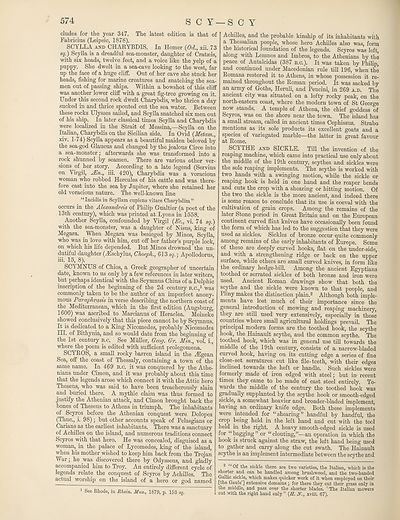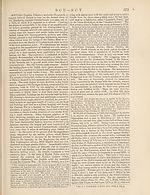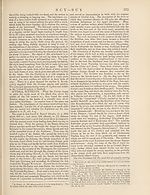Encyclopaedia Britannica > Volume 21, ROT-Siam
(584) Page 574
Download files
Complete book:
Individual page:
Thumbnail gallery: Grid view | List view

574 S C Y—S C Y
eludes for the year 347. The latest edition is that of
Fabricius (Leipsic, 1878).
SCYLLA and CHARYBDIS. In Homer (Od., xii. 73
sq.) Scylla is a dreadful sea-monster, daughter of Cratmis,
with six heads, twelve feet, and a voice like the yelp of a
puppy. She dwelt in a sea-cave looking to the west, far
up the face of a huge cliff. Out of her cave she stuck her
heads, fishing for marine creatures and snatching the sea¬
men out of passing ships. Within a bowshot of this cliff
was another lower cliff with a great fig-tree growing on it.
Under this second rock dwelt Charybdis, who thrice a day
sucked in and thrice spouted out the sea water. Between
these rocks Ulysses sailed, and Scylla snatched six men out
of his ship. In later classical times Scylla and Charybdis
were localized in the Strait of Messina,—Scylla on the
Italian, Charybdis on the Sicilian side. In Ovid (Metam.,
xiv. 1-74) Scylla appears as a beautiful maiden beloved by
the sea-god Glaucus and changed by the jealous Circe into
a sea-monster; afterwards she was transformed into a
rock shunned by seamen. There are various other ver¬
sions of her story. According to a late legend (Servius
on Virgil, JEn., iii. 420), Charybdis was a voracious
woman who robbed Hercules of his cattle and was there¬
fore cast into the sea by Jupiter, where she retained her
old voracious nature. The well-known line
“Incidis in Scyllam cupiens vitare Charybdim”
occurs in the Alexandreis of Philip Gualtier (a poet of the
13th century), which was printed at Lyons in 1558.
Another Scylla, confounded by Virgil (Ec., vi. 74 sq.)
with the sea-monster, was a daughter of Nisus, king of
Megara. When Megara was besieged by Minos, Scylla,
who was in love with him, cut off her father’s purple lock,
on which his life depended. But Minos drowned the un-
dutiful daughter (JEschylus, Choeph., 613 s?.; Apollodorus,
iii. 15, 8).
SCYMNUS of Chios, a Greek geographer of uncertain
date, known to us only by a few references in later writers,
but perhaps identical with the Scymnus Chius of a Delphic
inscription of the beginning of the 2d century b.c.,1 was
commonly taken to be the author of an imperfect anony¬
mous Paraphrasis in verse describing the northern coast of
the Mediterranean, which in the first edition (Augsburg,
1600) was ascribed to Marcianus of Heraclea. Meineke
showed conclusively that this piece cannot be by Scymnus.
It is dedicated to a King Nicomedes, probably Nicomedes
III. of Bithynia, and so would date from the beginning of
the 1st century b.c. See Muller, Geog. Gr. Min., vol. i.,
where the poem is edited with sufficient prolegomena.
SCYROS, a small rocky barren island in the Aegean
Sea, off the coast of Thessaly, containing a town of the
same name. In 469 b.c. it was conquered by the Athe¬
nians under Cimon, and it was probably about this time
that the legends arose which connect it with the Attic hero
Theseus, who was said to have been treacherously slain
and. buried there. A mythic claim was thus formed to
justify the Athenian attack, and Cimon brought back the
bones of Theseus to Athens in triumph. The inhabitants
of Scyros before the Athenian conquest were Dolopes
(Time., i. 98); but other accounts speak of Pelasgians or
Carians as the earliest inhabitants. There was a sanctuary
of Achilles on the island, and numerous traditions connect
Scyros with that hero. He was concealed, disguised as a
woman,, in the palace of Lycomedes, king of the island,
when his mother wished to keep him back from the Trojan
War; he was discovered there by Odysseus, and gladly
accompanied him to Troy. An entirely different cycle of
legends relate the conquest of Scyros by Achilles. The
actual worship on the island of a hero or god named
1 See Rhode, in Rhein. Mus., 1879, p. 153 sq.
Achilles, and the probable kinship of its inhabitants with
a Thessalian people, whose hero Achilles also was, form
the historical foundation of the legends. Scyros was left,
along with Lemnos and Imbros, to the Athenians by the
peace of Antalcidas (387 b.c.). It was taken by Philip,
and continued under Macedonian rule till 196, when the
Romans restored it to Athens, in whose possession it re¬
mained throughout the Roman period. It was sacked by
an army of Goths, Heruli, and Peucini, in 269 a.d. The
ancient city was situated on a lofty rocky peak, on the
north-eastern coast, where the modern town of St George
now stands. A temple of Athena, the chief goddess of
Scyros, was on the shore near the town. The island has
a small stream, called in ancient times Cephissus. Strabo
mentions as its sole products its excellent goats and a
species of variegated marble—the latter in great favour
at Rome.
SCYTHE and SICKLE. Till the invention of the
reaping machine, which came into practical use only about
the middle of the 19th century, scythes and sickles were
the sole reaping implements. The scythe is worked with
two hands with a swinging motion, while the sickle or
reaping hook is held in one hand and the reaper bends
and cuts the crop with a shearing or hitting motion. Of
the two the sickle is the more ancient, and indeed there
is some reason to conclude that its use is coeval with the
cultivation of grain crops. Among the remains of the
later. Stone period in Great Britain and on the European
continent curved flint knives have occasionally been found
the form of which has led to the suggestion that they were
used as sickles. Sickles of bronze occur quite commonly
among remains of the early inhabitants of Europe. Some
of these are deeply curved hooks, flat on the under-side,
and with a strengthening ridge or back on the upper
surface,, while others are small curved knives, in form like
the ordinary hedge-bill. Among the ancient Egyptians
toothed or serrated sickles of both bronze and iron were
used. Ancient Roman drawings show that both the
scythe and the sickle were known to that people, and
Pliny makes the distinction plain.2 Although both imple¬
ments have lost much of their importance since the
general introduction of mowing and reaping machinery,
they are still used very extensively, especially in those
countries where small agricultural holdings prevail. The
principal modern forms are the toothed hook, the scythe
hook, the Hainault scythe, and the common scythe. The
toothed hook, which was in general use till towards the
middle of the 19th century, consists of a narrow-bladed
curved hook, having on its cutting edge a series of fine
close-set serratures cut like file-teeth, with their edges
inclined towards the heft or handle. Such sickles were
formerly made of iron edged with steel; but in recent
times they came to be made of cast steel entirely. To¬
wards the middle of the century the toothed hook was
gradually supplanted by the scythe hook or smooth-edged
sickle, a somewhat heavier and broader-bladed implement,
having an ordinary knife edge. Both these implements
were intended for “shearing” handful by handful, the
crop being held in the left hand and cut with the tool
held in the right. A heavy smooth-edged sickle is used
for “bagging” or “clouting,”—an operation in which the
hook is struck against the straw, the left hand being used
to gather and carry along the cut swath. The Hainault
scythe is an implement intermediate between the scythe and
2 “Of the sickle there are two varieties, the Italian, which is the
shorter and can be handled among brushwood, and the two-handed
Gallic sickle, which makes quicker work of it when employed on their
[the Gauls’] extensive domains ; for there they cut their grass only in
the middle, and pass over the shorter blades. The Italian mowers
cut with the right hand only” (//. N., xviii. 67).
eludes for the year 347. The latest edition is that of
Fabricius (Leipsic, 1878).
SCYLLA and CHARYBDIS. In Homer (Od., xii. 73
sq.) Scylla is a dreadful sea-monster, daughter of Cratmis,
with six heads, twelve feet, and a voice like the yelp of a
puppy. She dwelt in a sea-cave looking to the west, far
up the face of a huge cliff. Out of her cave she stuck her
heads, fishing for marine creatures and snatching the sea¬
men out of passing ships. Within a bowshot of this cliff
was another lower cliff with a great fig-tree growing on it.
Under this second rock dwelt Charybdis, who thrice a day
sucked in and thrice spouted out the sea water. Between
these rocks Ulysses sailed, and Scylla snatched six men out
of his ship. In later classical times Scylla and Charybdis
were localized in the Strait of Messina,—Scylla on the
Italian, Charybdis on the Sicilian side. In Ovid (Metam.,
xiv. 1-74) Scylla appears as a beautiful maiden beloved by
the sea-god Glaucus and changed by the jealous Circe into
a sea-monster; afterwards she was transformed into a
rock shunned by seamen. There are various other ver¬
sions of her story. According to a late legend (Servius
on Virgil, JEn., iii. 420), Charybdis was a voracious
woman who robbed Hercules of his cattle and was there¬
fore cast into the sea by Jupiter, where she retained her
old voracious nature. The well-known line
“Incidis in Scyllam cupiens vitare Charybdim”
occurs in the Alexandreis of Philip Gualtier (a poet of the
13th century), which was printed at Lyons in 1558.
Another Scylla, confounded by Virgil (Ec., vi. 74 sq.)
with the sea-monster, was a daughter of Nisus, king of
Megara. When Megara was besieged by Minos, Scylla,
who was in love with him, cut off her father’s purple lock,
on which his life depended. But Minos drowned the un-
dutiful daughter (JEschylus, Choeph., 613 s?.; Apollodorus,
iii. 15, 8).
SCYMNUS of Chios, a Greek geographer of uncertain
date, known to us only by a few references in later writers,
but perhaps identical with the Scymnus Chius of a Delphic
inscription of the beginning of the 2d century b.c.,1 was
commonly taken to be the author of an imperfect anony¬
mous Paraphrasis in verse describing the northern coast of
the Mediterranean, which in the first edition (Augsburg,
1600) was ascribed to Marcianus of Heraclea. Meineke
showed conclusively that this piece cannot be by Scymnus.
It is dedicated to a King Nicomedes, probably Nicomedes
III. of Bithynia, and so would date from the beginning of
the 1st century b.c. See Muller, Geog. Gr. Min., vol. i.,
where the poem is edited with sufficient prolegomena.
SCYROS, a small rocky barren island in the Aegean
Sea, off the coast of Thessaly, containing a town of the
same name. In 469 b.c. it was conquered by the Athe¬
nians under Cimon, and it was probably about this time
that the legends arose which connect it with the Attic hero
Theseus, who was said to have been treacherously slain
and. buried there. A mythic claim was thus formed to
justify the Athenian attack, and Cimon brought back the
bones of Theseus to Athens in triumph. The inhabitants
of Scyros before the Athenian conquest were Dolopes
(Time., i. 98); but other accounts speak of Pelasgians or
Carians as the earliest inhabitants. There was a sanctuary
of Achilles on the island, and numerous traditions connect
Scyros with that hero. He was concealed, disguised as a
woman,, in the palace of Lycomedes, king of the island,
when his mother wished to keep him back from the Trojan
War; he was discovered there by Odysseus, and gladly
accompanied him to Troy. An entirely different cycle of
legends relate the conquest of Scyros by Achilles. The
actual worship on the island of a hero or god named
1 See Rhode, in Rhein. Mus., 1879, p. 153 sq.
Achilles, and the probable kinship of its inhabitants with
a Thessalian people, whose hero Achilles also was, form
the historical foundation of the legends. Scyros was left,
along with Lemnos and Imbros, to the Athenians by the
peace of Antalcidas (387 b.c.). It was taken by Philip,
and continued under Macedonian rule till 196, when the
Romans restored it to Athens, in whose possession it re¬
mained throughout the Roman period. It was sacked by
an army of Goths, Heruli, and Peucini, in 269 a.d. The
ancient city was situated on a lofty rocky peak, on the
north-eastern coast, where the modern town of St George
now stands. A temple of Athena, the chief goddess of
Scyros, was on the shore near the town. The island has
a small stream, called in ancient times Cephissus. Strabo
mentions as its sole products its excellent goats and a
species of variegated marble—the latter in great favour
at Rome.
SCYTHE and SICKLE. Till the invention of the
reaping machine, which came into practical use only about
the middle of the 19th century, scythes and sickles were
the sole reaping implements. The scythe is worked with
two hands with a swinging motion, while the sickle or
reaping hook is held in one hand and the reaper bends
and cuts the crop with a shearing or hitting motion. Of
the two the sickle is the more ancient, and indeed there
is some reason to conclude that its use is coeval with the
cultivation of grain crops. Among the remains of the
later. Stone period in Great Britain and on the European
continent curved flint knives have occasionally been found
the form of which has led to the suggestion that they were
used as sickles. Sickles of bronze occur quite commonly
among remains of the early inhabitants of Europe. Some
of these are deeply curved hooks, flat on the under-side,
and with a strengthening ridge or back on the upper
surface,, while others are small curved knives, in form like
the ordinary hedge-bill. Among the ancient Egyptians
toothed or serrated sickles of both bronze and iron were
used. Ancient Roman drawings show that both the
scythe and the sickle were known to that people, and
Pliny makes the distinction plain.2 Although both imple¬
ments have lost much of their importance since the
general introduction of mowing and reaping machinery,
they are still used very extensively, especially in those
countries where small agricultural holdings prevail. The
principal modern forms are the toothed hook, the scythe
hook, the Hainault scythe, and the common scythe. The
toothed hook, which was in general use till towards the
middle of the 19th century, consists of a narrow-bladed
curved hook, having on its cutting edge a series of fine
close-set serratures cut like file-teeth, with their edges
inclined towards the heft or handle. Such sickles were
formerly made of iron edged with steel; but in recent
times they came to be made of cast steel entirely. To¬
wards the middle of the century the toothed hook was
gradually supplanted by the scythe hook or smooth-edged
sickle, a somewhat heavier and broader-bladed implement,
having an ordinary knife edge. Both these implements
were intended for “shearing” handful by handful, the
crop being held in the left hand and cut with the tool
held in the right. A heavy smooth-edged sickle is used
for “bagging” or “clouting,”—an operation in which the
hook is struck against the straw, the left hand being used
to gather and carry along the cut swath. The Hainault
scythe is an implement intermediate between the scythe and
2 “Of the sickle there are two varieties, the Italian, which is the
shorter and can be handled among brushwood, and the two-handed
Gallic sickle, which makes quicker work of it when employed on their
[the Gauls’] extensive domains ; for there they cut their grass only in
the middle, and pass over the shorter blades. The Italian mowers
cut with the right hand only” (//. N., xviii. 67).
Set display mode to:
![]() Universal Viewer |
Universal Viewer | ![]() Mirador |
Large image | Transcription
Mirador |
Large image | Transcription
Images and transcriptions on this page, including medium image downloads, may be used under the Creative Commons Attribution 4.0 International Licence unless otherwise stated. ![]()
| Encyclopaedia Britannica > Encyclopaedia Britannica > Volume 21, ROT-Siam > (584) Page 574 |
|---|
| Permanent URL | https://digital.nls.uk/193634871 |
|---|
| Attribution and copyright: |
|
|---|---|
| Shelfmark | EB.17 |
|---|---|
| Description | Ten editions of 'Encyclopaedia Britannica', issued from 1768-1903, in 231 volumes. Originally issued in 100 weekly parts (3 volumes) between 1768 and 1771 by publishers: Colin Macfarquhar and Andrew Bell (Edinburgh); editor: William Smellie: engraver: Andrew Bell. Expanded editions in the 19th century featured more volumes and contributions from leading experts in their fields. Managed and published in Edinburgh up to the 9th edition (25 volumes, from 1875-1889); the 10th edition (1902-1903) re-issued the 9th edition, with 11 supplementary volumes. |
|---|---|
| Additional NLS resources: |
|

